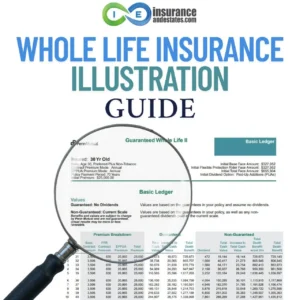Perhaps the most well known of the many benefit of life insurance is the death benefit. But most people, including your run of the mill life insurance agent, have no idea the subtle nuances of the death benefit.
One example is that, depending on your policy design, the death benefit for life insurance may continue to grow as you age. That means, the older you get, and the closer you are to that inevitable day when you will die, your death benefit is increasing. So, in the end, your death benefit will be at its largest when you pass on your wealth to your heirs.
What is a Death Benefit?
The definition of life insurance death benefit is the amount of money payable to the beneficiary or beneficiaries listed on a life insurance policy upon the death of the insured, minus any policy loans. It can include the base death benefit plus additional benefits due to supplemental riders and dividends. For it to be paid out, the policy must be in force, with all life insurance premiums paid up to the time of death.
The death benefit can also be defined as the face value or face amount of a life insurance policy. The face value does not always equal the death benefit, particularly when you are dealing with permanent coverage, such as whole life insurance, that has accompanying riders such as PUA riders and term riders and also has life insurance dividends that can increase the death benefit.
On a whole life insurance illustration, there is also a total death benefit guaranteed and total death benefit non-guaranteed shown. The total guaranteed death benefit is the total face amount guaranteed assuming no dividends were used to purchase paid-up additions, which could actually decrease the death benefit over time.
The total death benefit non-guaranteed is the illustrated amount that includes the sum of the guaranteed base policy death benefit, paid-up additions riders, plus the death benefit growth resulting from the illustrated dividend option and dividend scale.
How Long Before A Life Insurance Company Pays Out?
It typically takes around two weeks or so for the death benefit to be paid out, assuming all procedures are followed properly. The two main steps in this process are as follows:
- Submission of a death claim form by a beneficiary
- Submission of the insured’s certified copy of the death certificate
If there are multiple life insurance beneficiaries, each of them must send a separate death claim form to the insurance company. Among the items requested on the claim form are the insured’s name, social security number and policy number, as well as the claimant’s full name, social security number and date of birth.
A certified copy of the insured’s death certificate can typically be obtained from the County Recorders Office, Vital Records or the Mortuary. Death certificates are not always immediately available, so this can delay the death benefit claims process.
Contestability Period
If the insured dies during the “contestability” period of the contract, usually the first two years of the contract’s life, payment may be delayed as the insurance company checks the application to make sure there were no inaccuracies, whether intentional or inadvertent.
After the contestability period has passed, even if there were errors or deliberate misstatements on the application, the insurance company can no longer contest the application and must pay out the death benefit.
A life insurance death benefit payout can also be delayed if the proper paperwork is not sent to the insurance company in a timely manner.
How is the Death Benefit Paid?
Most often, the life insurance proceeds from the death benefit are paid out as a single lump sum. It can also be taken in the form of monthly or annual annuity payments.
Life insurance death benefit payments are not subject to the probate process, which can seriously delay the transfer of funds to an individual’s beneficiaries.
Is the Death Benefit Taxable?
Generally, the death benefit payout for life insurance is not taxable to the recipient beneficiary, whether a person or an organization. The exception to this is if you receive funds in excess of policy benefits. Any funds you receive over and above this amount are considered as income for tax purposes. If the death benefit amount you receive does not exceed the amount listed in the policy, the proceeds are tax free.
In cases where the employer of your spouse is the owner of the policy on behalf of your spouse, and the beneficiary is you or the employer, any proceeds above the premiums paid are considered to be taxable income to the death benefit’s recipient. If the provisions listed in IRS Publication 525 are met, income taxes on the payout can be avoided.
When the death benefit payments received exceed the stated amount, income taxes accrue as these payments are received. Such excess payments are usually caused by interest earned on premiums paid over the course of the policy’s life. IRS policy is to allow you to pro-rate the income portion of any excess death benefit amounts you may receive.
For life insurance policies that pay death benefits in the form of a lifetime payout, the portion of the payout that is not subject to tax if the policy has no refund provision or stated time period guarantee which is determined by dividing the amount of the death benefit by the life expectancy of the beneficiary.
Accelerated Death Benefits
When an insured is very ill, accelerated death benefits, such as a chronic illness rider or terminal illness rider, are sometimes paid out prior to the death of the insured. Generally, these benefits are not considered to be taxable income.
However, the IRS does not allow this exclusion for payouts to any persons or entities besides the insured if that person or entity is a director, officer, or employee of the insured or owns a financial stake in the insured’s business. To claim this exclusion for income tax purposes, IRS Form 8853 must be filed with your tax return.
An accelerated death benefit (ADB) payout allows the insured to access a portion of the death benefit in advanced if he or she is diagnosed withe a qualifying terminal illness or chronic illness. The money can be used for whatever you choose, such as home modifications, medical bills or perhaps one last vacation. The primary benefit of an ADB rider is that you have the money needed to get your house in order before you shuffle off this mortal coil.
Life Insurance Death Benefit vs Cash Value
The death benefit of a life insurance policy is the amount paid out upon the death of the insured, while cash value refers to the amount of funds in a permanent life insurance policy’s cash account.
Life insurance cash value is accessible to the policy owner in various ways, depending on the policy. If the policyowner dies while the policy remains in effect, the death benefit is paid out to the listed beneficiary or beneficiaries, while the cash value becomes the property of the insurance company.
The cash value held in a life insurance policy is determined by subtracting the cost of insurance and other charges levied by the insurance company from the total amount of premiums paid plus any interest or capital appreciation earned on the cash value.
Many policyowners who practice infinite banking or who have a life insurance retirement plan consider making use of the cash value they built up in their policy during their lifetimes. This can be done in a variety of ways, including:
- Withdrawal, subject to policy rules
- Taking out a policy loan, subject to policy rules
- Paying premiums
- Purchasing more death benefit in the form of paid-up-additions
Please note that any outstanding loans will be subtracted from the death benefit paid to a beneficiary or beneficiaries upon your death.
So, if you have a policy with a face value, or death benefit, of $200,000 and an outstanding loan of $50,000, your beneficiaries would be paid roughly $150,000 upon your death.
If you had a death benefit of $200,000 with no loan and $50,000 in the cash account, your beneficiaries would be paid $200,000 upon your death, while the $50,000 would be retained by the insurance company.
Does That Mean the Life Insurance Company Keeps My Cash Value?
Yes and no. The cash value often increases your death benefit. Particularly in the case of dividend paying whole life insurance, where the dividends purchase paid-up additional life insurance. The purchase of paid-up additions increases your death benefit and cash value. As your cash value grows, so does your death benefit. This continues until policy maturity at age 121, when the cash value and death benefit are the same.
Universal Life Death Benefits: Option A, Option B and Option C
Universal life insurance policies offer flexibility in choosing whether you want to set up the policy with a sizable death benefit or begin it with a lower death benefit that increases over time.
Option A
A universal life insurance option A policy has a stated death benefit or face value that remains level over the course of the contract’s life. The insurance carrier faces more risk early in the contract if the insured dies, as there is less cash value in the account. As the cash value rises, the carrier’s risk is reduced.
The benefit of option A to the policyholder is lower premiums. This type of universal life insurance generally offers the greatest death benefits relative to premium dollars spent of cash value policies. This type of insurance is usually purchased by people who are looking for permanent coverage with a significant death benefit who are not that concerned with building up early cash value.
A drawback of this option is that excess premiums must be paid in order to increase the death benefit. The amount of such premiums that can be used for this purpose is also typically subject to more limitations than under option B.
Option B
Universal life insurance structured under Option B is designed so that proceeds of the policy rise in value over time and equal the death benefit plus the cash value. As a result, the insurance carrier’s risk is equal to the policy’s face value or death benefit throughout the life of the contract.
To stay in compliance with guidelines promulgated by DEFRA (Deficit Reduction Act of 1984), the stated death benefit must rise along with cash value. The guidelines were established to set limits on the amount of excess premiums a policyholder could contribute to a policy for benefiting from the tax-advantaged status of proceeds from life insurance and avoid a modified endowment contract (MEC).
The main benefits of using option B are that this option enables cash value to grow more rapidly over the contract’s life and that the IRS allows higher levels of excess premium contributions under option B. The reason for quicker cash accumulation is the higher initial premiums along with a lower starting death benefit associated with this option. This enables a greater portion of the premium payments to be devoted to cash value.
Because there is more room for excess premium payments using this option, it is often chosen by a buyer with a young family looking to build-up tax-advantaged cash in the cash account.
The main drawback of option B is the combination of a lower starting death benefit and a higher initial premium amount. If the insured dies early in the policy’s life, the death benefit paid to beneficiaries will be much lower than would be the case if option A was chosen.
Option C
Option C death benefit is a return of premium death benefit option that is only available on certain policies at the time of issue.
Paid-up Insurance Additions
Life insurance paid-up additions (PUA) constitute an immediate purchase of paid-up life insurance coverage in the form of a death benefit. The paid-up additions rider can be a powerful tool for increasing your death benefit and cash value using either out of pocket funds or policy dividends.
If you plan to add this rider, it should be built into the policy when you purchase it. While a few insurance companies allow you to add the rider later, this can be expensive to do, especially if you have experienced health issues since the time you first bought the policy.
Any paid-up additions to a policy also earn dividends if you have purchased a policy from a mutual life insurance company that pays dividends, so their value continues to compound over time. You can surrender these additions if you choose for their cash value or you can take a loan out against them.
As cash value increases over time, this cash can be used to increase your death benefit without undergoing life insurance medical underwriting, which makes paid-up additions attractive to those whose health may have declined since the time they originally bought the policy.
Note that these paid-up additions may feature higher premiums even though they are not subject to medical underwriting, as the cost of insurance rises as you get older.
Different insurance companies have different policies in regard to paid-up additions riders. Some companies have flexible policies that allow you to make contributions of any amount from one year to the next, while others mandate that your contributions must remain at the same level if you want to avoid the risk of losing the rider and being required to apply for it again at a later date.
A simplistic example of how the rider could be used might be as follows: A 50-year-old male purchases a whole life policy with a yearly base premium of $4,000 dollars for a $200,000 death benefit. If, in the policy’s first year, the policyholder contributes an additional $5,000, these paid-up-additions boosts the policy’s cash value by $5,000 immediately while increasing the death benefit by $25,000. Additional contributions under the PUA rider will further increase both cash value and the death benefit.
While paid-up additions increase the death benefit received by your beneficiaries, they are often used primarily to increase a policy’s cash value. This helps those using permanent life insurance as an investment vehicle to accumulate savings which can grow in a tax-favored environment, preferably to be used in other wealth building strategies.
Conclusion
As you can see, a seemingly simple topic such as the life insurance death benefit is much more nuanced than you would expect. Life insurance is an asset that has been used over the last 150+ years to increase wealth and create a legacy. It is worth your time to investigate it further and not just accept the so-called financial experts’ dismissal of this amazing financial product.





